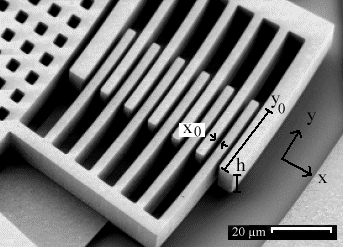Inside Mobile Sensors: MEMS Technology
Using technology always runs the risk of presenting itself as a “black box” to users. With mobile devices this is especially true, as it is frequently impossible to deconstruct the device and to see the microscopic elements that allow it to function. While most people are amazed at all of the things a smartphone can do in terms of collecting data, many are ultimately left with the question, "How does it do that?" Perhaps surprisingly, there is very little information available to the lay user to understand exactly how sensors work.

Because of this, we recently released an "Information" button on Android Physics Toolbox Sensor Suite, denoted by a small octagon and "!" embedded on each sensor tool. Information about generators, such as the speaker, illuminated screen, and flash is also available.
Many mobile device sensors are founded upon the principles of micro-electro-mechanical systems, or “MEMS” technology. Unfortunately, few resources exist that provide clear information on how these sensors work. Although it is possible to find technical information for sensors if their manufacturer is known, even that information is typically limited to physical specifications and developer information about signal transmission of the data for collection and manipulation. Technical specification sheets usually do not delve into the operating principles behind the sensor itself.
Given my own curiosity on the subject, and occasional requests from users, I began to look online for information. Doing a search on “How mobile sensors work,” I found nearly zero satisfactory sources. It wasn’t until I recognized the overarching “MEMS” concept, and also using the language “operating principle,” that my searches began to produce results. Even so, the information found was primarily intended for graduate students of engineering or academic and industrial researchers developing new technologies. Very little was available for the casual reader or for a student of introductory physics.
While all of the descriptions can be found in the new Android versions of Physics Toolbox Sensor Suite, it is still imperative to understand at least two operating principles beyond Ohm’s law in order to understand the explanations provided for each sensor. Namely, readers must understand the role of semiconductors and the function of capacitors in MEMS technology.
Semiconductors
Most MEMS technology use silicon for its abundance and for its many excellent physical traits. In addition to being used to guide current flow, silicon can be machined to create a variety of mechanical sensor mechanisms, including cantilevers and capacitive combs (click on the images to see their sources). This chapter presentation from an engineering course provides detailed, well-organized information about the appropriateness of silicon
to MEMS.
One property that is fully taken advantage of is its piezoresistive properties, which means that when silicon crystals experience physical stress (get bent), that their resistance changes.
One example application of this is in simple accelerometers, in which the sensor is composed of a long protrusions of silicon that bend under the weight of an inertial mass (sometimes a "paddle" of excess silicon at the end of the protrusion). As the accelerometer is flipped and turned in the presence of gravity, the protrusion bends under its weight, changing the resistance of the protrusion. See an excellent video from Engineer Guy for visuals on how both simple and more complex accelerometers function.
Likewise, silicon can be embedded into flexible membranes in the barometer, and as the membranes get stretched (due to the presence of increased/decreased air pressure of a membrane stretched over a closed cavity of air), the silicon pieces in the membrane also change resistance. See a video simulation of this process.
A mobile hygrometer works in a similar way, except that multiple silicon protrusions support a flexible membrane that allows water to adhere to it. As the membrane "sags" as it becomes saturate, it tugs at the protrusions and changes their resistance.
Capacitors
Capacitive combs are another approach used by sensors to measure changes in motion inside of sensors. Capacitors are composed of two or more plates that have opposite charges. As the distance between the plates decreases, or - in the case of the combs - as the amount of overlapping surface area increases - the capacitance of the plates increases, meaning that the opposite plates are each able to store more charge. The potential difference between the opposing plates or combs can be measured as they move with respect to one another.
Capacitors are especially helpful in precise accelerometers and gyroscopes. In the case of accelerometers, some of the combs move with respect to fixed plates as the mobile device is accelerated. In the case of gyroscopes, the combs are in forced resonance along a particular direction, and any rotation changes the resonant direction of the combs.
Although magnetometers do not use capacitive combs, some of them similarly rely on changes in potential difference across a surface. See a video here that describes the function of accelerometers, gyroscopes, and magnetometers, all of which are typically found on the same microchip.
See the Android version of Physics Toolbox Sensor Suite to access a number of other resources for each of these sensors, as well as to learn more about sensors such as the proximeter, ruler, compass, GPS, inclinometer, light meter, and sound meter.














